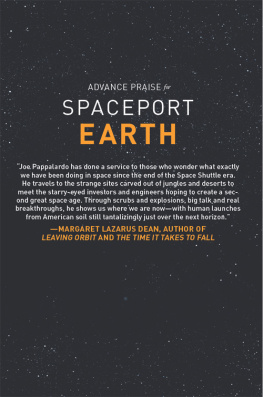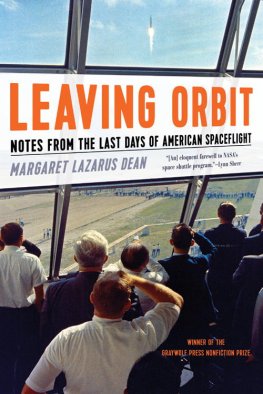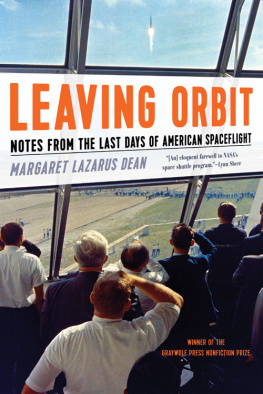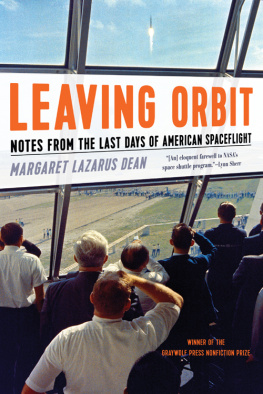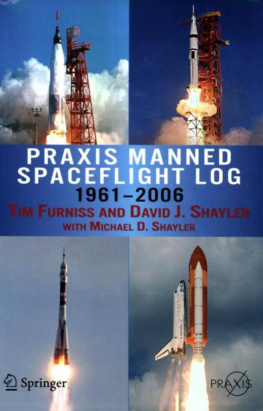This edition first published in hardcover in the United States in 2017 by
The Overlook Press, Peter Mayer Publishers, Inc.
N EW Y ORK
141 Wooster Street
New York, NY 10012
www.overlookpress.com
For bulk and special sales, please contact ,
or write us at the above address
L ONDON
30 Calvin Street
London E1 6NW
www.ducknet.co.uk
Copyright 2017 by Joe Pappalardo
All rights reserved. No part of this publication may be reproduced or transmitted in any form or by any means, electronic or mechanical, including photocopy, recording, or any information storage and retrieval system now known or to be invented, without permission in writing from the publisher, except by a reviewer who wishes to quote brief passages in connection with a review written for inclusion in a magazine, newspaper, or broadcast.
ISBN 978-1-4683-1564-6

The REINVENTION of SPACEFLIGHT
With 24 color photos, 4 b&w photos, and 1 map
IS THERE A FUTURE IN ORBIT? THIS TIMELY BOOK REVEALS THE STATE OF SPACEFLIGHT AT A CRUCIAL JUNCTURE IN THE INDUSTRYS HISTORY.
ITS THE 21ST-CENTURY and everything about the space industry is changing. Rather than despair over the end of American manned missions and a moribund commercial launch market, private sector companies are now changing the way humanity accesses orbit. Upstarts including Elon Musks SpaceX and Jeff Bezoss Blue Origin are building a dizzying array of new spacecraft and rockets, not just for government use, but for any paying customer. At the heart of this space revolution are spaceports, the center and literal launching pads of spaceflight. Spaceports cost hundreds of millions of dollars, face extreme competition, and host operations that do not tolerate failureswhich can often be fatal.
Aerospace journalist Joe Pappalardo has witnessed space rocket launches around the world, from the jungle of French Guiana to the coastline of California. In his comprehensive work Spaceport Earth, Pappalardo describes the rise of private companies in the United States and how they are reshaping the way the world is using space for industry and science. Spaceport Earth is a travelogue through modern space history as it is being made, offering space enthusiasts, futurists, and technology buffs a close perspective of rockets and launch sites, and chronicling the stories of industrial titans, engineers, government officials, billionaires, schemers, and politicians who are redefining what it means for humans to be a spacefaring species.
Man must rise above the Earthto the top of the atmosphere and beyondfor only thus will he fully understand the world in which he lives.
S OCRATES , philosopher
If there is a small rocket on top of a big one, and if the big one is jettisoned and the small one is ignited, then their speeds are added.
H ERMANN J ULIUS O BERTH , founding father of rocketry
A scientist describes what is. An engineer creates what never was.
T HEODORE VON K RMN , physicist and aerospace engineer
One day I would love to do a rock gig on the moon. How rad would that be?
T OMMY L EE , drummer, Mtley Cre
Map of US Spaceports
Commercial, Government, Private, and Proposed Launch Sites

Illustration credit: Federal Aviation Administration
A FTER FIVE MINUTES IN THE O RLANDO AIRPORT , I WANT TO RUN for the exit and speed to the spaceport at Cape Canaveral. It is July 5, 2011, and Im in Florida to witness the last flight of a US Space Shuttle. I imagine every moment at Kennedy Space Center over these next few days will be historic. The banality of the airport quickly becomes intolerable.
Im here to see the end of American human spaceflight, or at least what everyone says is the end. NASAs attitude seems to promote the pervasive, glum feeling of an era ending. They bill the last launch of the Space Shuttle Atlantis as The Grand Finale. This spacecraft has been flying my entire adult life, and now it is becoming obsolete. If I want to see this piece of aviation history anywhere but on display at a museum, its now or never.
As an editor at Popular Mechanics lucky enough to have supportive bosses, I can often self-assign stories that I want to cover. So I credential myself through NASAs media relations team, call Hearst Corporations travel office, start researching the hardware of a shuttle launch, and, almost as an afterthought, begin to explore the history of the spaceport here at Cape Canaveral.
Space Transportation System (STS)-135 will be the last shuttle launch, ever. But for me it will also be an inauguration. This will be the first space launch Ill ever see, despite the fact that Ive been covering spaceflight as a journalist for more than five years, including stints at Smithsonian Air & Space magazine and my current gig at Popular Mechanics. I have walked the empty halls of failed satellite launch companies in Dallas, interviewed legends like Gene Kranz and Buzz Aldrin, and toured the laboratory workshops of the Jet Propulsion Labs deep space projects. It wasnt the science but the engineering that first hooked me on the space beat: the dangerous vehicles, daring people who make and ride them, robotic expeditions to unfathomable environments, and high-stakes industries that formed around it all.
But for all I wrote about space, I have never seen an actual rocket launch, that first violent step needed to get up there, until now. To be honest, before today I thought about landing on other planets more than the brute effort it took to escape from this one.
Like a lot of people, the reality of the Space Shuttles retirement snuck up on me. The spacecraft seemed to be with me my whole life. I watched launches live on TV and as a kid once walked across the street to the Suffern High School lawn to watch a dot of light go past. My father assured me that it was the shuttle zipping past in orbit. I snuck out of class to watch Challenger rise on live TV, and returned to my classroom in shock after it detonated in midair. I was amazed by the in-space fix of the Hubble Space Telescope, astronauts doing work while perched on the tip of robotic arms, the Earth rotating beneath them. From an apartment in New York City, I numbly followed the cable news coverage of the tragedy of Columbia cracking up during reentry and scattering herself across half of Texas.
My interest drifted as the shuttle made repetitive missions to the International Space Stationa modern marvel, to be sure, but essentially an achingly slow construction project best appreciated when it was completed. But the drama of retirement has reignited my curiosity, and I leave in the airport in Orlando and head due east with high expectations.
I learn something very quickly about Cape Canaveral while driving into Cocoa Beach: Theres more going on here than just shuttle launches. Tall lightning rods mark the locations of other launch pads up and down the coast. The Air Force personnel at Patrick Air Force Base call this heavy-lift country because of the frequency of military and national security satellite launches that roar away from here every few months.
These routine aeronautical miracles dont get much attention in 2011the launches are in the hands of a capable but costly monopoly called the United Launch Alliance (formed by aerospace giants Lockheed Martin and Boeing) and not worthy of much public discussion. That, however, is destined to change. My visit will cross the historic intersection of two epochs of spaceflight, but its hard to think about that right now.

